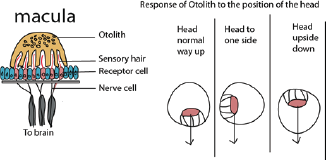
Detection of movement and posture of the body by the vestibular apparatus of the ear

The vestibular apparatus
The vestibular apparatus responsible for the sense movements in body and maintenance of dynamic equilibrium, consists of three semicircular canals in planes at right angles to each other.
At one end of each semicircular canal is a swelling (ampulla) which contains a receptor called a crista.
Each semicircular canal connects to two sacs called saccules and utricle often called Otolith organs.

The ampulla
The ampulla contains of a group of receptor cells with hairs embedded in in a dome shaped gelatinous cap, the Cupula sensitive to movements of the head.
The fact that, the three canals are in different planes ensures sensitivity to movement in any plane.
Because of inertia of the fluid in the semicircular canals, movement of the head deflects the ampulla in an opposite direction as shown by the figure below.

The deflection of the cupula puts mechanical strain on receptor cells, causing them to fire impulses to the brain
The utricle and saccule
The utricle and saccule contain specialized group of cells called macula that give information on the position/posture of the head.
Macula consists of a group of receptor cells, the free ends of which are embedded in a gelatinous substance containing a high concentration of dense particles of calcium carbonate called otolith. The role of otolith is to increase inertia.
According to the position of the head, the pull of gravity on the Otolith varies as shown in the diagram below.

The differential distortion of the receptor cells resulting from the head being held in difference position determines the pattern of impulses discharged by the nerve fibre to the brain.
Because of the way they are situated within the vestibular apparatus, the saccule is more sensitive to vertical acceleration (like riding in an elevator) and the utricle is more sensitive to horizontal acceleration (riding in a car).
